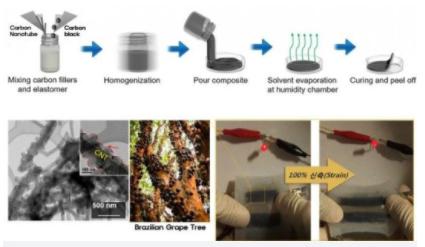A team of researchers has succeeded in developing world's first stretchable aqueous Li-ion Batteries that may power the next generation of wearable devices.
The current development of stretchable battery materials that mimic the functions of nature has emerged as a highly interesting research area, necessary for the next wave of wearable electronics.
A recent study, affiliated with UNIST has presented a bioinspired Jabuticaba-like hybrid carbon/polymer (HCP) composite that was developed into a stretchable current collector using a simple and cost-effective solution process. Using the HCP composite as a stretchable current collector, the research team has, for the first time, developed a highly stretchable Rechargeable Lithium-ion Battery (ARLB) based on aqueous electrolytes.
This breakthrough has been led by Professor Soojin Park in the School of Energy and Chemical Engineering in collaboration with Professor Kwanyong Seo and Professor So Youn Kim in the School of Energy and Chemical Engineering at UNIST.
Stretchable electronic devices have recently attracted tremendous attention as next-generation devices due to their immense flexibility. The increasing interest and demand of flexible electronics has fueled the search for highly stretchable electrodes with high mechanical durability and high electrical conductivity during deformation. Although many methods have been proposed for these electrodes, none of them has managed to simultaneously achieve high stretchability for the electrodes and have a scalable manufacturing process.
Professor Park solved such issues using a conductive polymer composite, composed of Jabuticaba-like hybrid carbon fillers containing carbon nanotubes and carbon black in a simple solution process. The shape of this structure resembled that of a Jabuticaba tree, the Brazilian grapetree.
The research team observed that the HCP composite is found to effectively retain its electrical conductivity, even under high strain rates. This makes it suitable for use in highly stretchable aqueous China Li-ion Batteries.
"Our findings are expected to expand the number of stretchable nanocomposites with electrochemical and mechanical properties available for use in a wide variety of applications,"says Professor Seo, who was in charge of the fabrication of stretchable current collectors.
A detailed analysis of the percolation behaviors of the conductive filler within the composite was done using an in situ SAXS measurement under stretching, which revealed that the different types of carbon in the filler led to a formation of highly interconnected cosupporting networks. Professor So Youn Kim led the in situ SAXS experiments. SAXS is a highly useful technique for measuring the behavior of nanofillers in polymer matrices. Besides, the research team has, for the first time, developed stretchable ARLB as a stretchable power source, using the HCP composite as a stretchable current collector and they have delivered stable power to a LED even under 100% strain.
"This study is expected to facilitate the design of stretchable nanocomposites with optimized electrochemical and mechanical properties for use in energy storage devices and stretchable electronics," says Professor Kim.

Previous: Hall Effect Current Sensor
Copyright:@2020-2021
Comments Please sign in or sign up to post.
0
0 of 500 characters used